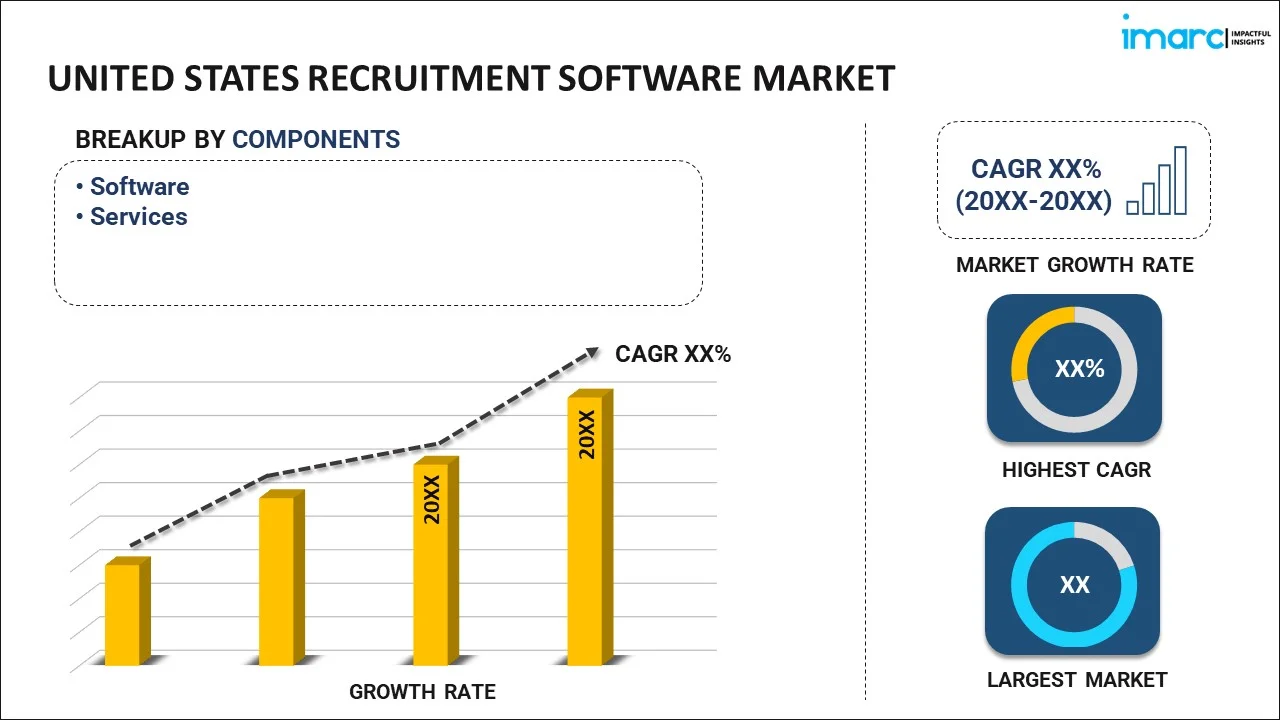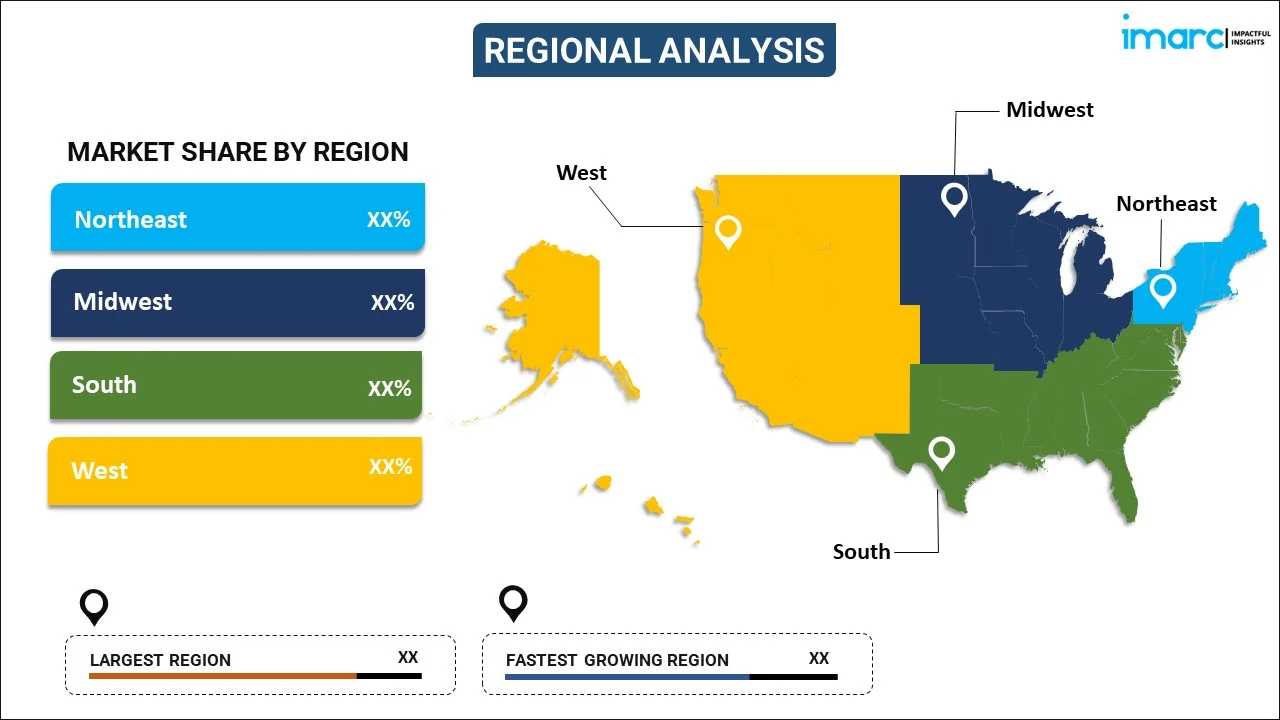
United States Recruitment Software Market Report by Component (Software, Services), Deployment Model (On-premises, SaaS Based), Enterprise Size (Small and Medium-Sized Enterprises, Large Enterprises), Vertical (Manufacturing, Healthcare, Hospitality, BFSI, Education, and Others), and Region 2025-2033
Market Overview:
United States recruitment software market size reached USD 592.0 Million in 2024. Looking forward, IMARC Group expects the market to reach USD 1,358.0 Million by 2033, exhibiting a growth rate (CAGR) of 9.7% during 2025-2033. The increasing demand to oversee the complete recruitment process and select the most suitable candidates, a preference shift towards cloud-based platforms, and the rising interest among small and medium-sized enterprises (SMEs) due to cost-effective maintenance are key factors propelling the market.
|
Report Attribute
|
Key Statistics
|
|---|---|
|
Base Year
|
2024
|
|
Forecast Years
|
2025-2033
|
|
Historical Years
|
2019-2024
|
| Market Size in 2024 | USD 592.0 Million |
| Market Forecast in 2033 | USD 1,358.0 Million |
| Market Growth Rate 2025-2033 | 9.7% |
Recruitment software is a specialized technological tool or platform designed to enhance and automate various facets of the hiring process, aiding organizations in more efficiently managing their recruitment endeavors. Typically encompassing features like applicant tracking, resume parsing, job posting, candidate sourcing, interview scheduling, and analytical/reporting capabilities, this software centralizes candidate data. It empowers recruiters and hiring managers to effectively navigate the hiring pipeline, screen resumes, maintain communication with candidates, and ultimately make well-informed hiring decisions. The software contributes to the streamlining and acceleration of recruitment workflows, diminishing manual tasks, fostering collaboration among hiring teams, and elevating overall recruitment outcomes. By optimizing the recruitment process, it not only saves time but also enhances the quality of candidate selection, establishing itself as a valuable tool aligning with contemporary talent acquisition strategies.
United States Recruitment Software Market Trends:
The United States recruitment software market is a thriving sector, driven by the increasing need for organizations to efficiently manage and optimize their hiring processes. Additionally, this specialized technology platform is designed to automate and streamline various aspects of recruitment, providing features such as applicant tracking, resume parsing, job posting, candidate sourcing, interview scheduling, and robust analytics/reporting capabilities. Besides this, one of the notable trends influencing the market is the shift towards cloud-based solutions, allowing for greater flexibility and accessibility. Furthermore, the demand for recruitment software is particularly pronounced among small and medium-sized enterprises (SMEs), drawn by its cost-effective maintenance and the ability to navigate the entire recruitment cycle seamlessly. As the competition for top talent intensifies, organizations across the U.S. are adopting recruitment software to centralize candidate data, enhance collaboration among hiring teams, and make data-driven decisions. The software not only accelerates recruitment workflows, reducing manual tasks, but also improves the overall quality of candidate selection. In the dynamic landscape of talent acquisition, the U.S. recruitment software market will continue to play a pivotal role in shaping modern hiring strategies and facilitating efficient, tech-driven recruitment processes across industries over the forecasted period.
United States Recruitment Software Market Segmentation:
IMARC Group provides an analysis of the key trends in each segment of the market, along with forecasts at the country level for 2025-2033. Our report has categorized the market based on component, deployment model, enterprise size, and vertical.
Component Insights:

- Software
- Contact Management
- Resume Management
- Mobile Recruitment
- Reporting and Analytics
- Workflow Management
- Others
- Services
- Professional
- Managed
The report has provided a detailed breakup and analysis of the market based on the component. This includes software (contact management, resume management, mobile recruitment, reporting and analytics, workflow management, and others) and services (professional and managed).
Deployment Model Insights:
- On-premises
- SaaS Based
A detailed breakup and analysis of the market based on the deployment model have also been provided in the report. This includes on-premises and SaaS based.
Enterprise Size Insights:
- Small and Medium-Sized Enterprises
- Large Enterprises
The report has provided a detailed breakup and analysis of the market based on the enterprise size. This includes small and medium-sized enterprises and large enterprises.
Vertical Insights:
- Manufacturing
- Healthcare
- Hospitality
- BFSI
- Education
- Others
A detailed breakup and analysis of the market based on the vertical have also been provided in the report. This includes manufacturing, healthcare, hospitality, BFSI, education, and others.
Regional Insights:

- Northeast
- Midwest
- South
- West
The report has also provided a comprehensive analysis of all the major regional markets, which include Northeast, Midwest, South, and West.
Competitive Landscape:
The market research report has also provided a comprehensive analysis of the competitive landscape. Competitive analysis such as market structure, key player positioning, top winning strategies, competitive dashboard, and company evaluation quadrant has been covered in the report. Also, detailed profiles of all major companies have been provided.
United States Recruitment Software Market Report Coverage:
| Report Features | Details |
|---|---|
| Base Year of the Analysis | 2024 |
| Historical Period | 2019-2024 |
| Forecast Period | 2025-2033 |
| Units | Million USD |
| Scope of the Report | Exploration of Historical Trends and Market Outlook, Industry Catalysts and Challenges, Segment-Wise Historical and Future Market Assessment:
|
| Components Covered |
|
| Deployment Models Covered | On-premises, SaaS Based |
| Enterprise Sizes Covered | Small and Medium-Sized Enterprises, Large Enterprises |
| Verticals Covered | Manufacturing, Healthcare, Hospitality, BFSI, Education, Others |
| Regions Covered | Northeast, Midwest, South, West |
| Customization Scope | 10% Free Customization |
| Post-Sale Analyst Support | 10-12 Weeks |
| Delivery Format | PDF and Excel through Email (We can also provide the editable version of the report in PPT/Word format on special request) |
Key Questions Answered in This Report:
- How has the United States recruitment software market performed so far and how will it perform in the coming years?
- What has been the impact of COVID-19 on the United States recruitment software market?
- What is the breakup of the United States recruitment software market on the basis of component?
- What is the breakup of the United States recruitment software market on the basis of deployment model?
- What is the breakup of the United States recruitment software market on the basis of enterprise size?
- What is the breakup of the United States recruitment software market on the basis of vertical?
- What are the various stages in the value chain of the United States recruitment software market?
- What are the key driving factors and challenges in the United States recruitment software?
- What is the structure of the United States recruitment software market and who are the key players?
- What is the degree of competition in the United States recruitment software market?
Key Benefits for Stakeholders:
- IMARC’s industry report offers a comprehensive quantitative analysis of various market segments, historical and current market trends, market forecasts, and dynamics of the United States recruitment software market from 2019-2033
- The research report provides the latest information on the market drivers, challenges, and opportunities in the United States recruitment software market.
- Porter's five forces analysis assist stakeholders in assessing the impact of new entrants, competitive rivalry, supplier power, buyer power, and the threat of substitution. It helps stakeholders to analyze the level of competition within the United States recruitment software industry and its attractiveness.
- Competitive landscape allows stakeholders to understand their competitive environment and provides an insight into the current positions of key players in the market.
Need more help?
- Speak to our experienced analysts for insights on the current market scenarios.
- Include additional segments and countries to customize the report as per your requirement.
- Gain an unparalleled competitive advantage in your domain by understanding how to utilize the report and positively impacting your operations and revenue.
- For further assistance, please connect with our analysts.
 Inquire Before Buying
Inquire Before Buying
 Speak to an Analyst
Speak to an Analyst
 Request Brochure
Request Brochure
 Request Customization
Request Customization




.webp)




.webp)












